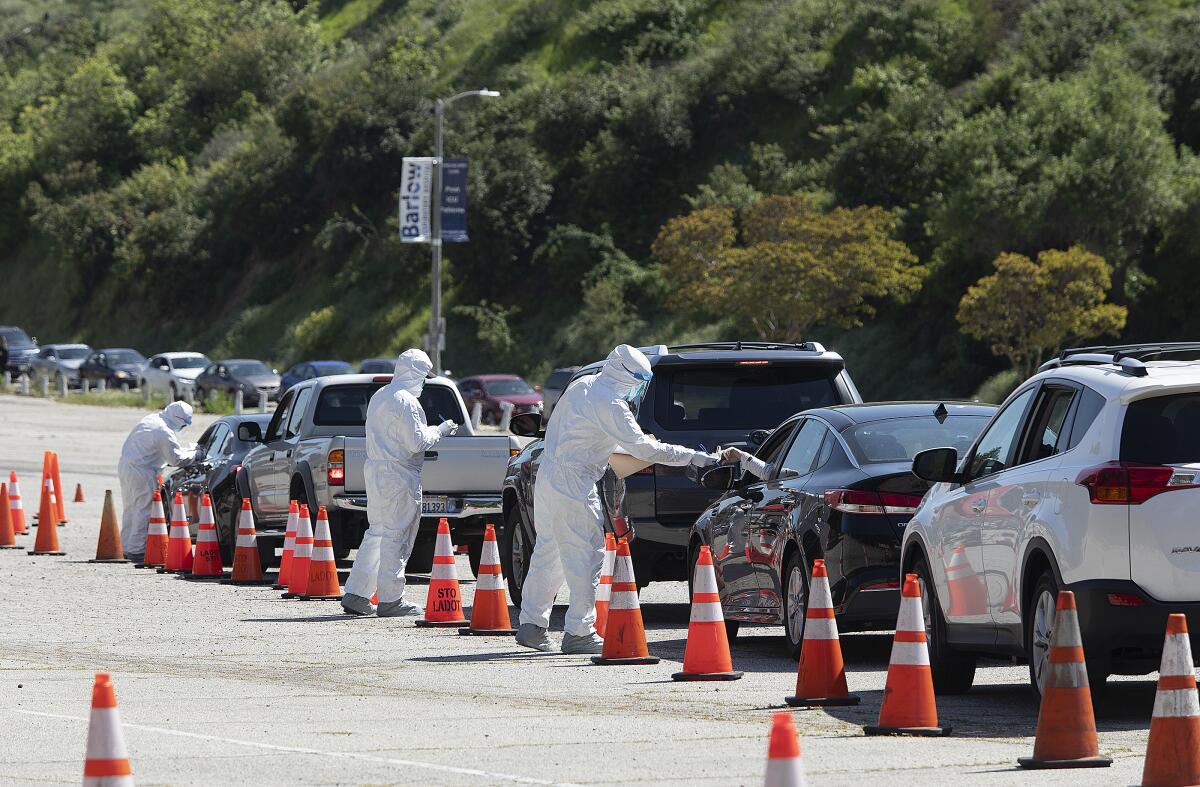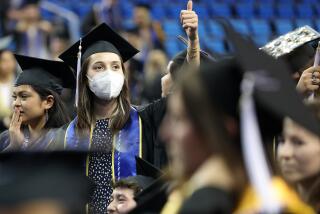Column: I got tested for COVID-19. Should you?

The last time I traveled along Stadium Way I was headed to a Dodger game, but on Monday afternoon I drove to the fire training center near the ballpark for a much less enjoyable experience.
A COVID-19 test.
No beer, no Dodger dogs. Just a cotton swab and a five-minute drive-through, with results to follow in a few days.
I was conflicted about being tested, for two reasons.
First, while we definitely needed to ramp up testing back at the beginning of this crisis, I’m wondering if the county has now gone overboard in offering free testing to all residents, whether or not they have symptoms.
Second, I’m pretty sure that my minor allergy-like symptoms are just that: allergies. But as someone who is almost 67, with a couple of minor health issues, I thought I should make sure. Not just for the benefit of loved ones, but because I’m in contact with other people while out and about on interviews.
As of Tuesday, about 350,000 people in L.A. County had been tested and roughly 33,000 of them, or 9%, were positive.
“So long as COVID-19 spreads, we have to scale up our response — and because this disease can be a silent killer, we have carefully built the capacity to get more people tested,” Mayor Eric Garcetti said in announcing the testing partnership with L.A. County. “No one should have to wait, wonder, or risk infecting others. Don’t leave it to chance. Schedule a test.”
The theory is that such testing could prevent asymptomatic super-spreaders from infecting others. And it could help identify trend lines and give us a better picture of what percentage of the public is sick, and when we can safely begin returning to school and to work.
But not everyone believes that it’s practical or even desirable to test people who have no symptoms.
Dr. Clayton Kazan, medical director of the L.A. County Fire Department and an emergency room physician, said he’s all for routine testing of people in high-risk situations, such as staffers at elder-care facilities. He also supports the testing of first responders, and his firefighters are participating in a long-term UCLA study that will monitor the health of front-line workers.
But Kazan thinks “massive testing of asymptomatic people, without consideration of what their risk is, is of low value by definition.” And there’s the possibility, he added, of inaccurate test results as well as the possibility that people will test negative one day and contract the virus the next.
“The false negative rate is between 10% and 30%, and we know the cost for doing the tests at public sites is about $125 per test,” Kazan said. “If I test a thousand asymptomatic people and find one or two out of a thousand [who are positive], or three out of a thousand, that’s a high cost … so I definitely question the value.”
Dr. Michael Hochman, a Keck Medical Center physician and director of the USC Gehr Family Center for Health Systems Science and Innovation, said some experts have called for repeated testing of the entire population, which would be highly impractical and wouldn’t necessarily be all that useful.
“While mass Covid-19 testing might seem intuitive, its benefits are unlikely to meet the high expectations for it,” Hochman wrote in a piece published last week by the health news website STAT.
People who have COVID-19 symptoms should be tested, Hochman said. For those who don’t, testing might have some value in advancing our understanding of the virus, but for it to be really useful would require millions and millions of tests and close analysis of the data produced.
“I just don’t think the juice is worth the squeeze, especially since it’s the simple things that are going to get us out of this epidemic,” Hochman said, speaking of the time between now and the development of a vaccine.
What kind of simple things?
There are four of them, Hochman said. And you’ve heard them before.
Wash your hands frequently and meticulously. Repeatedly clean all surfaces with virus-killing solutions. Social distance yourself from others as much as possible. And wear a mask if you’re in the company of others.
I’m still getting pushback for my Sunday column about the benefits of wearing masks. Hochman said he used to doubt the efficacy of masks but has become a convert based on his reading of the scientific data. There’s no use in wearing a mask outdoors if nobody is near you, he said. Otherwise, cover your face.
“If we do these four things very consistently, the data is showing more and more that that’s going to have a dramatic effect,” Hochman said.
I asked Dr. Sharon Balter, director of communicable disease control for the L.A. County Department of Public Health, what she thought about the second-guessing of current testing policy. She said she and other public officials have been having those very discussions, and Balter expects COVID-19 response strategies to be refined in coming days.
“This is new, and we’re learning, and we don’t have all the answers,” Balter said. “But widespread testing of asymptomatic people is not necessarily all that helpful, and it can give people a false sense of, ‘I’m tested, so I’m safe.’”
One goal of making free testing available to everyone was to make sure those without access to private healthcare could get tested, Balter said. But going forward, she said, testing may be targeted more at those with symptoms and the people they have come into contact with. Tests will also be conducted anywhere there’s an outbreak or cluster of cases.
“I think people understand that the answer is not any one thing, and testing is just a piece of it,” Balter said, echoing Hochman’s prescription of distancing, sanitizing and face covering.
I’ve done all those things as much as possible, but there’s always room for improvement.
Waiting for the results from the lab is like waiting for my report card. I hope the news is good, and that the next time I’m back in that neighborhood it’s to see a Dodgers game.
More to Read
Sign up for Essential California
The most important California stories and recommendations in your inbox every morning.
You may occasionally receive promotional content from the Los Angeles Times.











